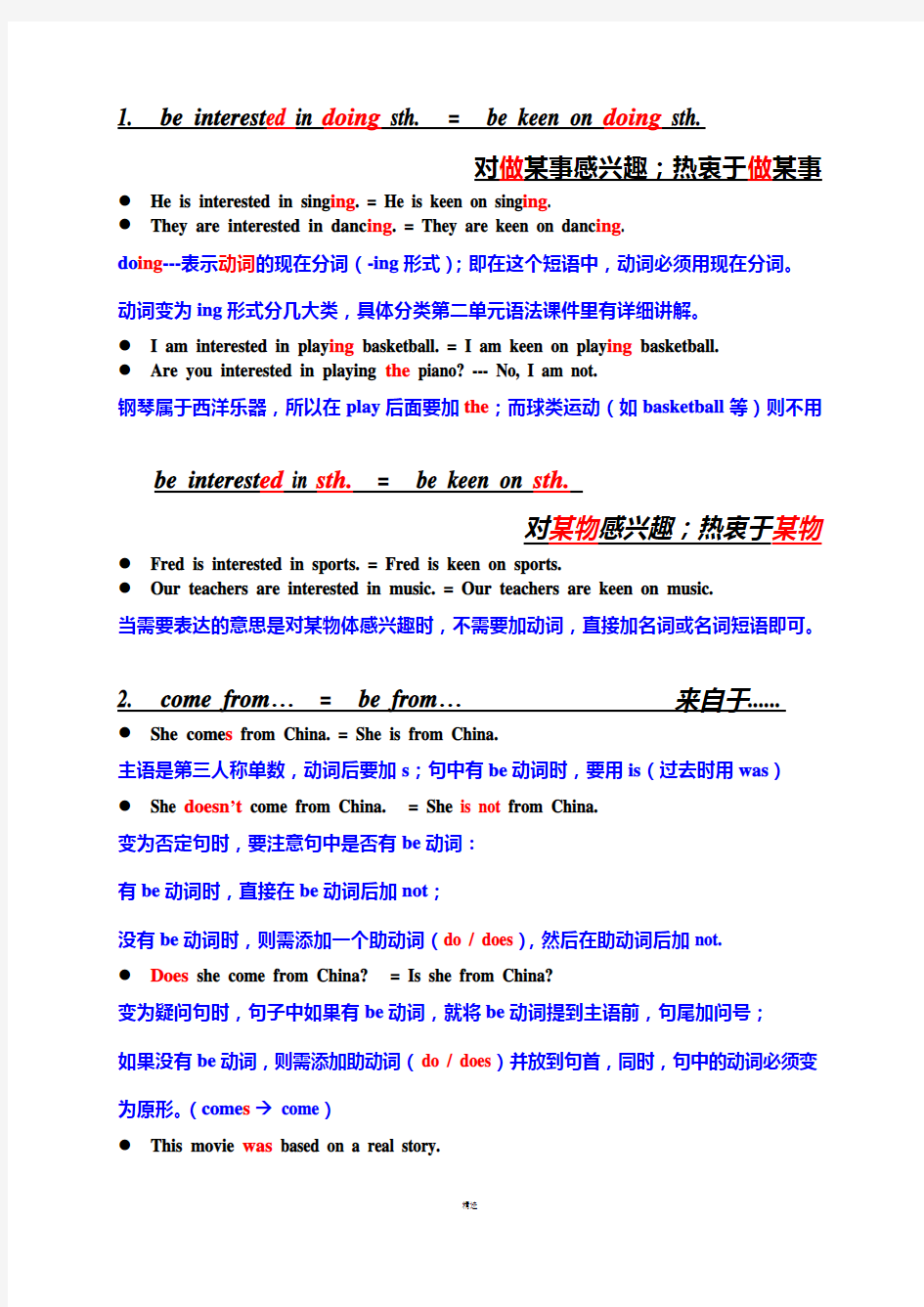
英语重点短语用法详解
- 格式:doc
- 大小:72.00 KB
- 文档页数:7


1. be interest ed in doing sth. = be keen on doing sth.
对做某事感兴趣;热衷于做某事●He is interested in sing ing. = He is keen on sing ing.
●They are interested in danc ing. = They are keen on danc ing.
do ing---表示动词的现在分词(-ing形式);即在这个短语中,动词必须用现在分词。动词变为ing形式分几大类,具体分类第二单元语法课件里有详细讲解。
●I am interested in play ing basketball. = I am keen on play ing basketball.
●Are you interested in playing the piano? --- No, I am not.
钢琴属于西洋乐器,所以在play后面要加the;而球类运动(如basketball等)则不用
be interest ed in sth.= be keen on sth.
对某物感兴趣;热衷于某物●Fred is interested in sports. = Fred is keen on sports.
●Our teachers are interested in music. = Our teachers are keen on music.
当需要表达的意思是对某物体感兴趣时,不需要加动词,直接加名词或名词短语即可。
2. come from…= be from…来自于......
●She come s from China. = She is from China.
主语是第三人称单数,动词后要加s;句中有be动词时,要用is(过去时用was)
●She doesn’t come from China. = She is not from China.
变为否定句时,要注意句中是否有be动词:
有be动词时,直接在be动词后加not;
没有be动词时,则需添加一个助动词(do / does),然后在助动词后加not.
●Does she come from China? = Is she from China?
变为疑问句时,句子中如果有be动词,就将be动词提到主语前,句尾加问号;
如果没有be动词,则需添加助动词(do / does)并放到句首,同时,句中的动词必须变为原形。(come s→ come)
●This movie was based on a real story.
= This movie was from a real story.
= This movie c a me from a real story.
这部电影是根据一个真实故事改编的。(这部电影来自一个真实的故事)be based on...意思是“以...为基础”;
在例句的这种情况中,可以用be from和come from来替换。(其它时候不可以替换)电影的改编过程,通常都是已经完成的事情,所以大多用过去式。
be动词的过去式为was, were;动词过去式大部分直接加ed,但也有少数特殊变化。
●Was this movie based on a real story?
= Was this movie from a real story? = Did this movie come from a real story?
变为疑问句时,特别要注意动词的时态;动词过去式决定助动词必须用did.
3. pass sb. sth. = pass sth. to sb. 把某物(sth.)传/递给某人(sb.)
●Can you pass me the cup please? = Can you pass the cup to me please?
Can意思是“能够”,属于情态动词。
只要有情态动词,动词永远都用原形,不再受主语影响
●Tom pass ed his brother a pen just now.
= Tom pass ed a pen to his brother just now.
just now意为“刚才”,说明句子是过去时,所以动词要变过去式
●Did Tom pass his brother the pen just now?
= Did Tom pass the pen to his brother just now?
过去时,句中没有“be动词”,变疑问句时要用“助动词”did
4. each other = one an other 彼此,互相
●We always help each other. = We always help one another.
句中有频率副词always,表示习惯性的动作,说明句子是一般现在时
主语不是第三人称单数,所以动词用原形
频率副词(由高至低排列):always → usually → often → sometimes → seldom → never
总是通常经常有时候很少从不
●Do trees often communicate with each other?
= Do trees often communicate with one another?
句中有频率副词often,说明这是一般现在时的句子
主语不是第三人称单数,所以动词用原形
句中没有be动词,变疑问句时要用助动词do
●They trusted each other two years ago. = They trusted one another two years ago.
句中有表示时间的短语two years ago,说明这是过去时的句子,动词trust要变过去式●Did they trust each other two years ago? =Did they trust one another two years ago? 过去时的句子,句中没有be动词时,变疑问句时要用助动词did
5. Why not do sth. ? = Why don’t you do sth. ? 不如......(提建议)
●Why not walk to school? = Why don’t you walk to school?
这两个句子的共同点在于,动词都要用原形;
而不同点也很明显,Why not后面直接加动词,但是如果是Why don’t,则必须要加上对于听取这条建议的人的称呼,即例句中的you,然后再加动词。
6. be famous for... = be well-know n for... 以......而闻名
●Beijing is famous for the Great Wall. = Beijing is well-known for the Great Wall.
这两个短语之所以意思相同,仅仅是因为famous和well-known这两个单词意思相同;而短语里的其他部分(be动词和介词for)是完全不变的。
注意well-known的拼写,这是一个独立的单词,中间的短横线“-”一定要写上!
7. offer sb. sth. = offer sth. to sb.
= provide sth. for sb. = provide sb. with sth.
为某人提供某物
●Our school offer s
= Our school offer